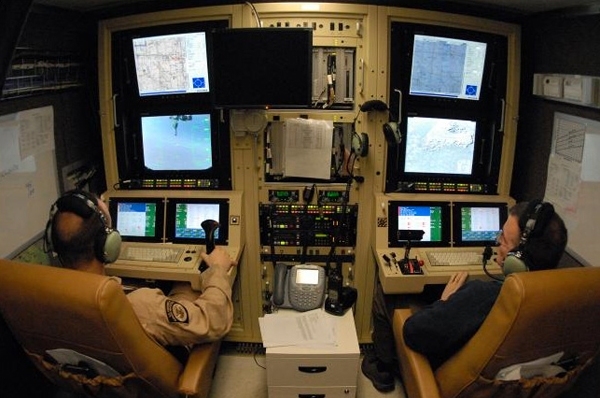On its surface, operating a military drone looks a lot like playing a video game: Operators sit at workstations, manipulating joysticks to remotely adjust a drone’s pitch and elevation, while grainy images from the vehicle’s camera project onto a computer screen. An operator can issue a command to fire if an image reveals a hostile target, but such adrenaline-charged moments are few and far between.
Instead, a drone operator — often a seasoned fighter pilot — spends most of his shift watching and waiting, as automated systems keep the vehicle running. Such shifts can last up to 12 hours, as is the case for operators of the MQ-1 Predator, a missile-loaded unmanned aerial vehicle (UAV) used by the U.S. Air Force for overseas surveillance and combat.
“You might park a UAV over a house, waiting for someone to come in or come out, and that’s where the boredom comes in,” says Mary “Missy” Cummings, associate professor of aeronautics and astronautics and engineering systems at MIT. “It turns out it’s a much bigger problem in any system where a human is effectively babysitting the automation.”
Cummings says such unstimulating work environments can impair performance, making it difficult for an operator to jump into action in the rare instances when human input is needed. She and researchers in MIT’s Humans and Automation Lab are investigating how people interact with automated systems, and are looking for ways to improve UAV operator performance.
In a study to be published in the journal Interacting with Computers, Cummings’ team found that operators working with UAV simulations were less bored, and performed better, with a little distraction. While the study’s top performer spent the majority of time concentrating on the simulation, the participants with the next-highest scores performed almost as well, even though they were distracted nearly one-third of the time.
The findings suggest that distractions may help avoid boredom, keeping people alert during otherwise-tedious downtimes.
“We know that pilots aren’t always looking out the window, and we know that people don’t always pay attention in whatever they’re doing,” Cummings says. “The question is: Can you get people to pay attention enough, at the right time, to keep the system performing at a high degree?”
Keeping boredom at bay
The researchers set up an experiment in which participants interacted with a UAV simulation in four-hour shifts. During the simulation, subjects monitored the activity of four UAVs, and created “search tasks,” or areas in the terrain for UAVs to investigate. Once a UAV identified a target, participants labeled it as hostile or friendly, based on a color-coded system. For hostile targets, subjects issued a command for a UAV to fire, destroying a target, and earning points in the simulation.
The researchers videotaped each participant throughout the experiment, noting when an operator was engaged with the system, and when he or she was distracted and facing away from the computer screen.
The person with the highest score overall was the one who paid the most attention to the simulation. “She’s the person we’d like to clone for a boring, low-workload environment,” Cummings says — but such a work ethic may not be the norm among most operators.
Cummings and her colleagues found that the next-best performers — who scored almost as high — were distracted 30 percent of the time, either checking their cellphones, reading a book, or getting up to snack.
The team also found that while the simulation only required human input 5 percent of the time, most people “made themselves busy” in the simulation for 11 percent of the time — an indication that participants wanted more to do, to keep from getting bored.
Cummings says creating busywork or distractions once in a while may, in fact, be good for productivity, keeping an operator engaged when he or she may otherwise lose focus.
Personality complex
Cummings says personality may also be a consideration in hiring UAV operators. In the same experiment, she asked participants to fill out a personality survey that ranked them in five categories: extroversion, agreeableness, conscientiousness, neuroticism and openness to experience. The group found among the top performers, conscientiousness was a common personality trait. Cummings says conscientious people may work well in low-taskload environments such as UAV operation — although she says they may also hesitate when the time comes to fire a weapon.
“You could have a Catch-22,” Cummings says. “If you’re high on conscientiousness, you might be good to watch a nuclear reactor, but whether these same people would be effective in such military settings is unclear.”
“It’s an aphorism that ‘war is long periods of boredom punctuated by moments of sheer terror,’” says Lawrence Spinetta, a lieutenant colonel in the U.S. Air Force and a former Predator squadron commander. “That's true in spades for unmanned aircraft combat operations.”
Spinetta says the success of UAV missions depends on keeping operators alert — a challenging task when missions can run for months at a time without a day of rest.
“A mission may be to watch a suspected location where a terrorist is hiding for days, weeks, or even months,” Spinetta says. “Attention to detail is required for success. That can go out the window when boredom sets in. Thus analyzing ways to overcome, address and analyze boredom, which is the thrust of this paper, is critical to mission effectiveness.”
Cummings’ group is continuing to run experiments to tease out conditions that may improve performance and discourage boredom: For example, periodic alerts may redirect an operator’s attention. The group is also looking into shift duration, and the optimal period for operator productivity.
“We need people who can monitor these systems and intervene, but that might not be very often,” Cummings says. “This will be a much bigger problem in five to 10 years because we’re going to have so much more automation in our world.”
Study shows distractions may alleviate boredom and improve drone operators’ performance.
Publication Date:

Credits:
Photo: Department of Defense





